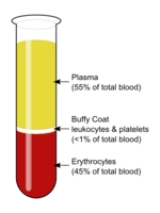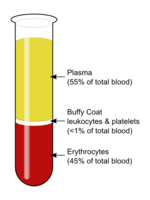
Buffy coat
Encyclopedia

Blood fractionation
Blood fractionation is the process of fractionating whole blood, or separating it into its component parts. This is typically done by centrifuging the blood.The resulting components are:...
of an anticoagulated
Anticoagulant
An anticoagulant is a substance that prevents coagulation of blood. A group of pharmaceuticals called anticoagulants can be used in vivo as a medication for thrombotic disorders. Some anticoagulants are used in medical equipment, such as test tubes, blood transfusion bags, and renal dialysis...
blood
Blood
Blood is a specialized bodily fluid in animals that delivers necessary substances such as nutrients and oxygen to the cells and transports metabolic waste products away from those same cells....
sample after density gradient centrifugation
Centrifugation
Centrifugation is a process that involves the use of the centrifugal force for the sedimentation of mixtures with a centrifuge, used in industry and in laboratory settings. More-dense components of the mixture migrate away from the axis of the centrifuge, while less-dense components of the mixture...
that contains most of the white blood cell
White blood cell
White blood cells, or leukocytes , are cells of the immune system involved in defending the body against both infectious disease and foreign materials. Five different and diverse types of leukocytes exist, but they are all produced and derived from a multipotent cell in the bone marrow known as a...
s and platelet
Platelet
Platelets, or thrombocytes , are small,irregularly shaped clear cell fragments , 2–3 µm in diameter, which are derived from fragmentation of precursor megakaryocytes. The average lifespan of a platelet is normally just 5 to 9 days...
s.
Description
After centrifugation, one can distinguish a layer of clear fluid (the plasmaBlood plasma
Blood plasma is the straw-colored liquid component of blood in which the blood cells in whole blood are normally suspended. It makes up about 55% of the total blood volume. It is the intravascular fluid part of extracellular fluid...
), a layer of red fluid containing most of the red blood cell
Red blood cell
Red blood cells are the most common type of blood cell and the vertebrate organism's principal means of delivering oxygen to the body tissues via the blood flow through the circulatory system...
s, and a thin layer in between, making up less than 1% of the total volume of the blood sample, the buffy coat (so-called because it is usually buff
Buff (colour)
Buff is a pale yellow-brown colour that got its name from the colour of buff leather.Displayed on the right is the colour buff.EtymologyAccording to the Oxford English Dictionary, buff as a descriptor of a colour was first used in the London Gazette of 1686, describing a uniform to be "A Red Coat...
in hue), with most of the white blood cells and platelet
Platelet
Platelets, or thrombocytes , are small,irregularly shaped clear cell fragments , 2–3 µm in diameter, which are derived from fragmentation of precursor megakaryocytes. The average lifespan of a platelet is normally just 5 to 9 days...
s. The buffy coat is used, for example, to extract DNA
DNA
Deoxyribonucleic acid is a nucleic acid that contains the genetic instructions used in the development and functioning of all known living organisms . The DNA segments that carry this genetic information are called genes, but other DNA sequences have structural purposes, or are involved in...
from the blood of mammal
Mammal
Mammals are members of a class of air-breathing vertebrate animals characterised by the possession of endothermy, hair, three middle ear bones, and mammary glands functional in mothers with young...
s (since mammalian red blood cells are anucleate
Cell nucleus
In cell biology, the nucleus is a membrane-enclosed organelle found in eukaryotic cells. It contains most of the cell's genetic material, organized as multiple long linear DNA molecules in complex with a large variety of proteins, such as histones, to form chromosomes. The genes within these...
and do not contain DNA).
The buffy coat is usually whitish in color but sometimes green, if the blood sample contains large amounts of neutrophils
Neutrophil granulocyte
Neutrophil granulocytes are the most abundant type of white blood cells in mammals and form an essential part of the innate immune system. They are generally referred to as either neutrophils or polymorphonuclear neutrophils , and are subdivided into segmented neutrophils and banded neutrophils...
, which are high in green myeloperoxidase
Myeloperoxidase
Myeloperoxidase is a peroxidase enzyme that in humans is encoded by the MPO gene. Myeloperoxidase is most abundantly expressed in neutrophil granulocytes . It is a lysosomal protein stored in azurophilic granules of the neutrophil...
. The layer next to buffy coat contains granulocytes and red blood cells.
Diagnostic Uses of the Buffy Coat
- Quantitative Buffy Coat (QBC) is a laboratoryMedical laboratoryA medical laboratory or clinical laboratory is a laboratory where tests are done on clinical specimens in order to get information about the health of a patient as pertaining to the diagnosis, treatment, and prevention of disease.-Departments:...
test to detect infection with malariaMalariaMalaria is a mosquito-borne infectious disease of humans and other animals caused by eukaryotic protists of the genus Plasmodium. The disease results from the multiplication of Plasmodium parasites within red blood cells, causing symptoms that typically include fever and headache, in severe cases...
or other blood parasites: the blood is taken in a QBC capillary tube which is coated with acridine orangeAcridine orangeAcridine orange is a nucleic acid selective fluorescent cationic dye useful for cell cycle determination. It is cell-permeable, and interacts with DNA and RNA by intercalation or electrostatic attractions respectively. When bound to DNA, it is very similar spectrally to fluorescein, with an...
(a fluorescent dye) and centrifuged; the fluorescingFluorescenceFluorescence is the emission of light by a substance that has absorbed light or other electromagnetic radiation of a different wavelength. It is a form of luminescence. In most cases, emitted light has a longer wavelength, and therefore lower energy, than the absorbed radiation...
parasites can then be observed under ultravioletUltravioletUltraviolet light is electromagnetic radiation with a wavelength shorter than that of visible light, but longer than X-rays, in the range 10 nm to 400 nm, and energies from 3 eV to 124 eV...
light at the interface between red blood cells and buffy coat. This test is more sensitive than the conventional thick smear and in >90% of cases, the species of parasite can also be identified. - In cases of extremely low white blood cell count, it may be difficult to perform a manual differential of the various types of white cells, and it may be virtually impossible to obtain an automated differential. In such cases the medical technologistMedical technologistA Medical Laboratory Scientist is a healthcare professional who performs chemical, hematological, immunologic, microscopic, and bacteriological diagnostic analyses on body fluids such as blood, urine, sputum, stool, cerebrospinal fluid , peritoneal fluid, pericardial fluid, and synovial...
may obtain a buffy coat, from which a blood smear is made. This smear contains a much higher number of white blood cells than whole blood.

